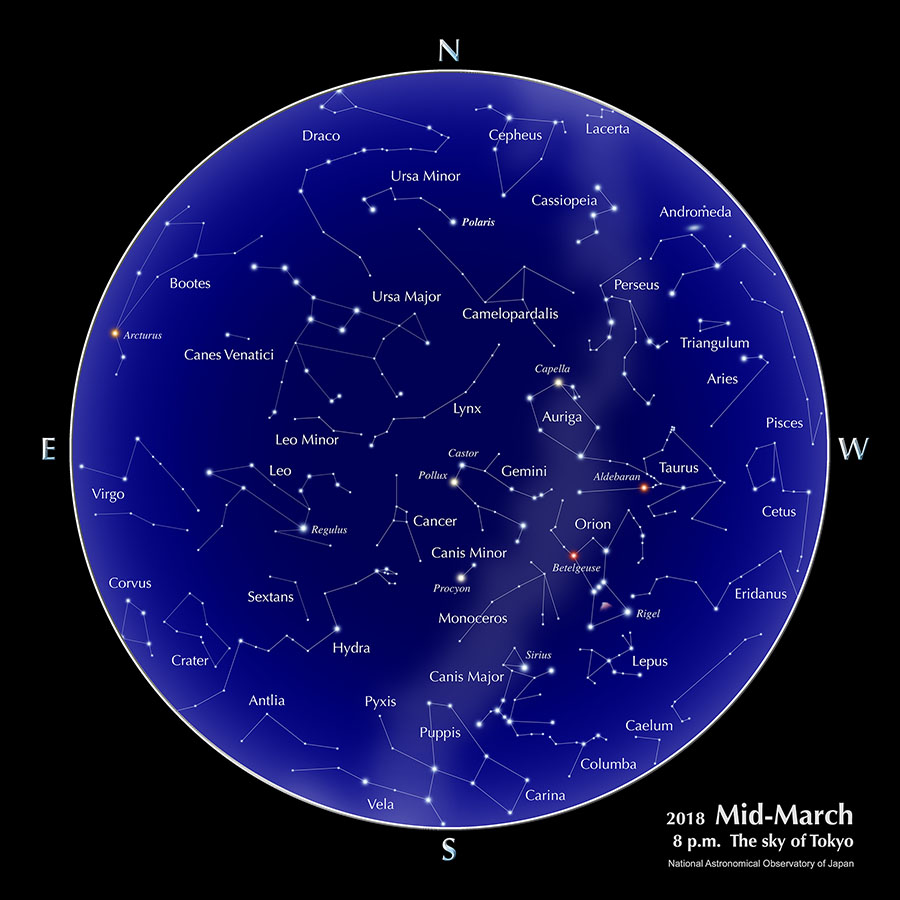The sky of Tokyo, Calendar, Planets (March, 2018)
The sky of Tokyo

Calendar (March)
| 2 | Full Moon |
| 4 | Neptune at conjunction |
| 9 | Jupiter at stationary point / Last Quarter Moon |
| 16 | Greatest Eastern Elongation of Mercury |
| 17 | New Moon |
| 21 | Vernal Equinox Day [Shunbun-no-hi] (national holiday) / Vernal equinox (Sun’s ecliptic longitude 0°) |
| 23 | Mercury at stationary point |
| 25 | First Quarter Moon |
| 31 | Full Moon |
Planets
- Mercury
- In the beginning of March, Mercury’s apparent location is close to the Sun, so it is not suited for observation. Mercury reaches greatest eastern elongation on March 16. It can be easily found in the lower western sky several days before and after March 16. From March 11 to March 20, at 30 minutes after sunset, its elevation as seen from Tokyo is higher than 10 degrees. In the end of March, its apparent location is close to the Sun, making observations difficult. Its brightness is -0.8 magnitude to 0.7 magnitude from March 11 to March 20.
- Venus
- Venus shines in the lower western sky just after sunset. In the end of March, 30 minutes after sunset, its elevation as seen from Tokyo is higher than 10 degrees. Its brightness is -3.9 magnitude.
- Mars
- In the beginning of the month, Mars is located in the constellation Ophiuchus and moves east (direct motion). In the middle of the month, it moves to the constellation Sagittarius. It can be seen in the southern sky before sunrise. Its brightness is 0.8 magnitude to 0.3 magnitude.
- Jupiter
- Jupiter moves east (direct motion) in the constellation Libra and reaches its stationary point on March 9. After passing the stationary point, it moves to the west (retrograde motion). At the stationary point, Jupiter seems to stop with respect to the stars. It can be seen before sunrise moving from the southern to southwestern sky. Its brightness is -2.2 magnitude to -2.4 magnitude.
- Saturn
- Saturn moves east (direct motion) in the constellation Sagittarius. It can be seen before sunrise moving from the southeastern to southern sky. Its brightness is 0.6 magnitude to 0.5 magnitude.
Reference: Ephemeris Computation Office, NAOJ
With the “Sky Viewer” you can easily explore the appearance of a typical urban night sky (planets and constellations are visible). The Celestial Phenomena section of the glossary explains the planetary phenomena terms: greatest elongation, opposition, conjunction, stationary, etc.